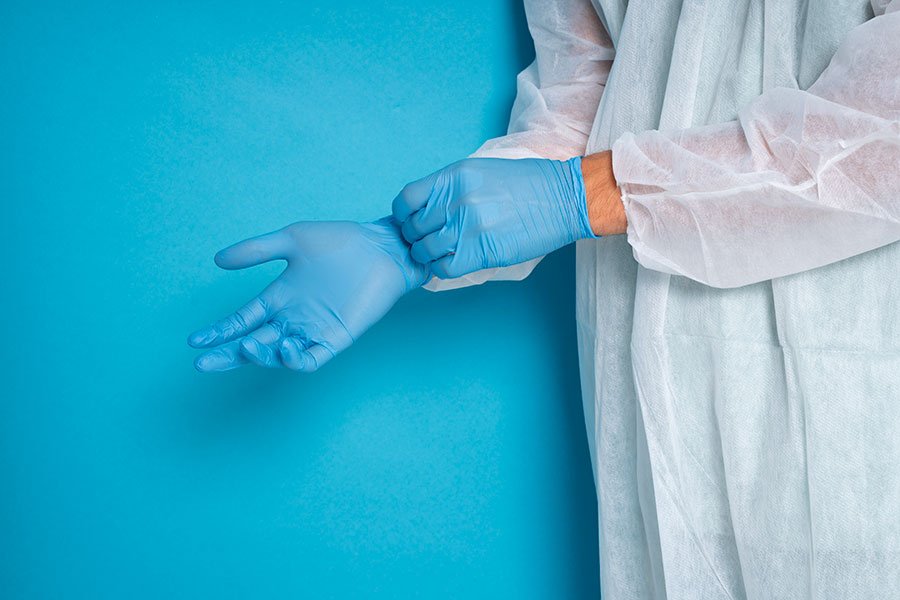Disposable gloves can be simply divided into ordinary disposable gloves and disposable medical gloves. Do you know the difference between both of them?
Different uses
Ordinary disposable gloves
Daily work (non-medical work) and operations in life that require hand protection, such as industrial manufacturing, cleaning labor protection, experimental chemistry, or certain operations that have hygiene requirements, such as food processing.
Medical disposable gloves
Surgical operations such as various surgeries, central catheter placement, total parenteral nutrition solution preparation, etc.; direct or indirect contact with the patient’s blood, body fluids, secretions, excretions, and items that are contaminated by body fluids.
Different materials
Ordinary disposable gloves
There are many types of materials, in addition to natural rubber gloves, nitrile rubber gloves, polyethylene (PE) gloves, and polyvinyl chloride (PVC) gloves, there are also cloth gloves, leather gloves, etc.
Medical disposable gloves
Medical gloves are mainly divided into natural rubber gloves, nitrile rubber gloves, polyethylene (PE) gloves, and polyvinyl chloride (PVC) gloves according to the material.
Different characteristics
Ordinary disposable gloves
The surface is soaked with chloroprene rubber; cotton padding; and a diamond-shaped outer pattern.
There are no obvious impurities and stains on the surface, the joints should be firm and leak-free, the tensile strength should be ≥1.0N, and the elongation at break should be ≥5%; the initial contamination of the product shall not exceed 100cfu/g, and pathogenic bacteria shall not be detected after ethylene oxide disinfection, the ethylene oxide residue shall not be greater than 10ug/g, and the skin irritation reaction shall not exceed level I.
Therefore, when choosing disposable medical gloves, you can start with the following aspects:
Regular manufacturers
Disposable medical gloves on the market are mixed, and the quality is uneven. Choose regular medical glove manufacturers with complete glove certificates and clear labels to achieve process traceability and avoid unnecessary risks.
Behind the qualified medical gloves packaging, the certificate name (CFDA), registration number, product technical requirements number, country of origin, production date and shelf life, and production batch number are printed. (If it contains an old version of the SFDA certificate, it should be marked with the product standard number, registration number, etc.)
Glove material
The two most common materials for disposable medical gloves are nitrile and latex. Disposable medical latex gloves are made of natural rubber, have good elasticity and soft texture, and provide comfortable flexibility for the hands.
Nitrile gloves can perfectly remember hand movements and will not feel tired even after wearing them for a long time. Selecting high-quality natural nitrile is not easy to cause allergies, and is the first choice for medical staff who are allergic to latex protein or have sensitive skin. It has puncture resistance, establishes a protective barrier on the surface of the hands of medical staff, and reduces the risk of hand skin being scratched by medical devices.
The “micro-pockmarked surface” on the surface of medical gloves of both materials provides a firm grip so that medical staff will not slip when taking surgical instruments, causing safety hazards. You can choose nitrile or latex gloves according to your personal preference, but from the overall comfort and technological content, we recommend nitrile gloves.
Glove types
In terms of venue, medical gloves are usually divided into examination gloves and surgical gloves. Medical examination gloves are generally used to examine the patient’s oral cavity or skin surface and must contain a CFDA experimental drug safety certification. Excellent tensile elongation, strong wear resistance, can adapt to various weak acid and weak alkali environments inside the human skin.
Based on meeting the safety requirements required for examination gloves, surgical gloves have higher safety requirements. Further sterilization is required and they are individually packaged; at the same time, they conform to the ergonomic curved hand shape, fit closely with the five fingers, and are comfortable to wear.
Even during long-term surgery, excellent humidity control can maintain the shape and fit of the gloves worn by medical staff and safely operate medical equipment.
Powder-free gloves are better than powdered gloves
Gloves on the market are also divided into powdered and powder-free. To ensure safety, the powder in Medis powdered medical latex gloves is made of food-grade corn starch that can be absorbed by the human body and is easy to wear.
In the medical field, it is safer to use powder-free med



